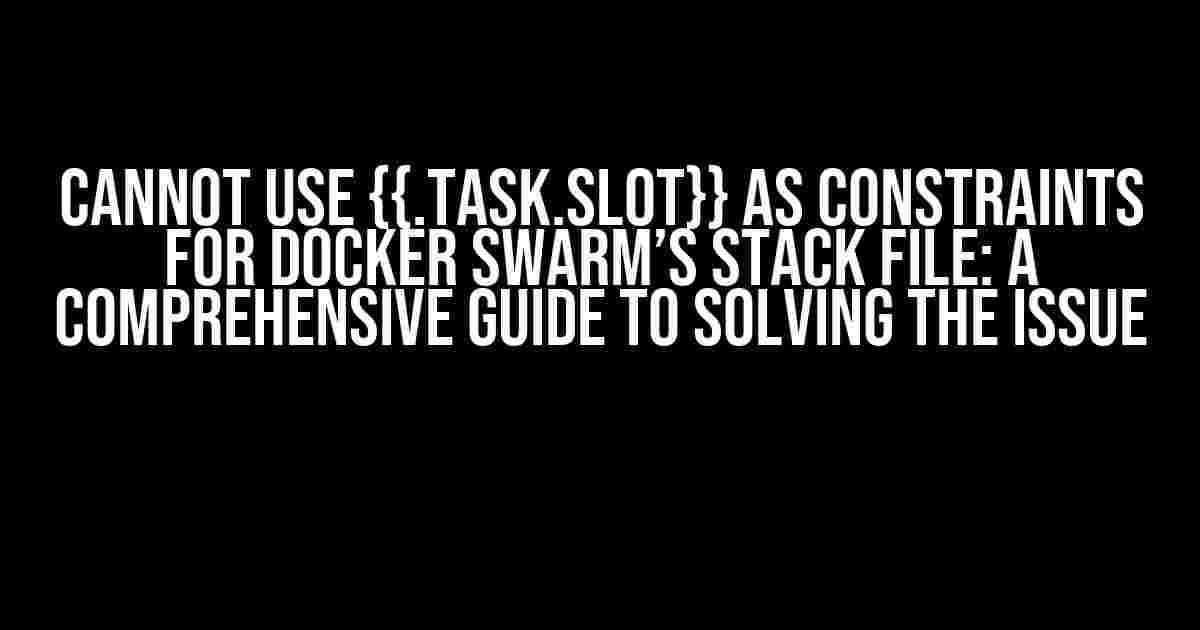Are you tired of encountering the frustrating error “Cannot use {{.Task.Slot}} as constraints for docker swarm’s stack file”? You’re not alone! Many developers have stumbled upon this issue, and in this article, we’ll delve into the root cause of the problem and provide a step-by-step solution to get you back on track.
Understanding Docker Swarm and Stack Files
Before we dive into the solution, let’s take a moment to understand the basics of Docker Swarm and stack files.
Docker Swarm is a clustering and orchestration tool for Docker containers. It allows you to deploy and manage containerized applications at scale. Swarm mode enables you to create a cluster of Docker nodes and deploy services to it.
A stack file, on the other hand, is a YAML file that defines the services, networks, and volumes for a Docker Swarm application. It’s used to deploy and manage complex applications in a Swarm cluster.
The Problem: {{.Task.Slot}} as Constraints
So, what’s the issue with using {{.Task.Slot}} as constraints in a Docker Swarm stack file? The problem arises when you try to use the {{.Task.Slot}} variable as a constraint in your stack file. This variable is used to specify the slot number of a task in a Swarm service, but it’s not designed to be used as a constraint.
When you try to use {{.Task.Slot}} as a constraint, Docker Swarm throws an error, stating that it cannot be used as a constraint for the stack file. This is because constraints are used to define the deployment requirements for a service, such as node labels, resources, and placement.
Solution: Using Node Labels Instead
So, how do you solve this issue? The solution lies in using node labels instead of {{.Task.Slot}} as constraints. Node labels are key-value pairs that can be assigned to Docker nodes to describe their characteristics, such as availability zone, instance type, or hardware capabilities.
Here’s an example of how you can use node labels to achieve the same effect as using {{.Task.Slot}}:
version: '3'
services:
myservice:
...
deploy:
mode: replicated
replicas: 3
placement:
max-replicas-per-node: 1
constraints:
- node.labels.slot == 0
- node.labels.slot == 1
- node.labels.slot == 2
In this example, we’re using node labels to specify the slot number for each node. We’re then using these labels as constraints to ensure that the service is deployed to nodes with the corresponding slot number.
Step-by-Step Guide to Implementing Node Labels
Here’s a step-by-step guide to implementing node labels and constraints in your Docker Swarm stack file:
-
Create a node label for each slot number:
docker node update --label-add slot=0 node1 docker node update --label-add slot=1 node2 docker node update --label-add slot=2 node3 -
Update your stack file to use node labels as constraints:
version: '3' services: myservice: ... deploy: mode: replicated replicas: 3 placement: max-replicas-per-node: 1 constraints: - node.labels.slot == 0 - node.labels.slot == 1 - node.labels.slot == 2 -
Deploy your stack file to Docker Swarm:
docker stack deploy --compose-file stack.yml myapp
Additional Tips and Best Practices
In addition to using node labels as constraints, here are some additional tips and best practices to keep in mind:
-
Use meaningful and descriptive node labels to ensure that your constraints are clear and easy to understand.
-
Avoid using complex node labels or constraints that can lead to deployment issues or conflicts.
-
Test your stack file and node labels in a development environment before deploying to production.
-
Use Docker Swarm’s built-in validation tool to check your stack file for errors and inconsistencies.
Conclusion
In conclusion, the “Cannot use {{.Task.Slot}} as constraints for docker swarm’s stack file” error can be resolved by using node labels as constraints instead. By following the step-by-step guide and best practices outlined in this article, you can ensure that your Docker Swarm application is deployed and managed efficiently and effectively.
Remember, Docker Swarm is a powerful tool for container orchestration, and with the right approach, you can overcome common errors and achieve high availability, scalability, and reliability for your applications.
| Keyword | Definition |
|---|---|
| {{.Task.Slot}} | A variable used to specify the slot number of a task in a Swarm service. |
| Node Labels | Key-value pairs assigned to Docker nodes to describe their characteristics. |
| Constraints | Rules used to define the deployment requirements for a service in a Swarm cluster. |
By the end of this article, you should have a clear understanding of why {{.Task.Slot}} cannot be used as constraints and how to use node labels as a solution. If you have any further questions or concerns, feel free to ask in the comments below!
Happy coding!
Frequently Asked Question
Got stuck with Docker swarm’s stack file? Don’t worry, we’ve got you covered! Check out these frequently asked questions and get back to deploying your app in no time!
Why can’t I use {{.Task.Slot}} as a constraint in my Docker swarm’s stack file?
The {{.Task.Slot}} variable is not available for use as a constraint in a Docker swarm’s stack file. This is because constraints are evaluated before the task is created, and {{.Task.Slot}} is only available once the task is running. Instead, you can use {{.Node.ID}} or {{.Node.Hostname}} as constraints.
What happens if I try to use {{.Task.Slot}} as a constraint in my Docker swarm’s stack file?
If you try to use {{.Task.Slot}} as a constraint in your Docker swarm’s stack file, you’ll get an error message saying that the variable is not valid. This is because, as mentioned earlier, {{.Task.Slot}} is only available once the task is running, and constraints are evaluated before the task is created. So, it’s not possible to use {{.Task.Slot}} as a constraint.
Can I use other variables as constraints in my Docker swarm’s stack file?
Yes, you can use other variables as constraints in your Docker swarm’s stack file! For example, you can use {{.Node.ID}}, {{.Node.Hostname}}, {{.Node.Labels}}, and more. These variables are available during the constraint evaluation phase, so you can use them to define constraints for your services.
How do I debug constraints in my Docker swarm’s stack file?
To debug constraints in your Docker swarm’s stack file, you can use the `docker stack deploy` command with the `–resolve-image` flag. This flag will show you the resolved constraints for each service in your stack file. You can also check the Docker swarm logs to see why a particular service is not being deployed due to a constraint issue.
Where can I find more information about Docker swarm’s stack file constraints?
You can find more information about Docker swarm’s stack file constraints in the official Docker documentation. Specifically, check out the sections on “Constraints” and “Templates” in the “Compose file” documentation. You can also search online for tutorials and blog posts about using constraints in Docker swarm’s stack files.



